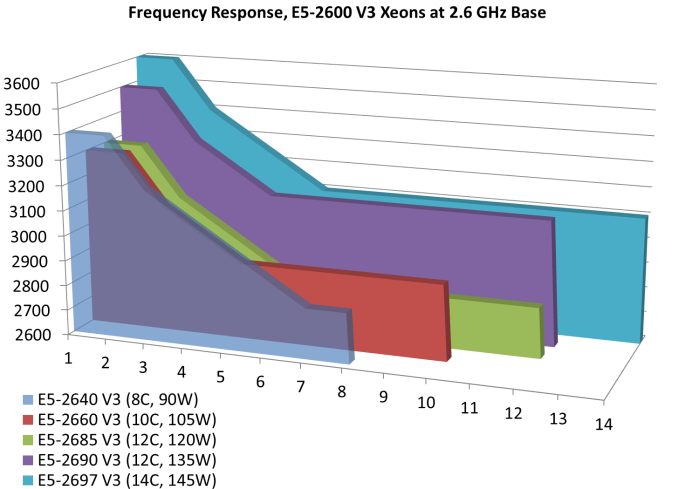Intel Haswell-EP Xeon 14 Core Review: E5-2695 V3 and E5-2697 V3
by Ian Cutress on November 20, 2014 10:00 AM ESTE5-2695 V3 and E5-2697 V3 Conclusion
Reviewing CPUs that differ only in CPU count or clock speed but are based on similar architectures is predominantly a point and click affair. The CPU with the higher single core frequency does well in response focused benchmarks, and those with more cores with enough memory bandwidth to support them. For Xeons, the price difference for more cores or more frequency never makes much sense if you calculate the difference in terms of power, but becomes more realistic when the time-to-complete for intensive workloads is taken into account. To throw a spanner into the mix, as Johan found in his Haswell-EP testing, Xeons like the E5-2667 v3 exist to take advantage of higher AVX clock speeds due to increased power headroom, accelerating mixed-AVX workloads more than a higher core-count model which has to reduce frequency to compensate. The E5-2667 v3 therefore costs an extra $1000+ over its nearest core counterpart.
The two CPUs we have reviewed today, the E5-2695 V3 and E5-2697 V3, fall directly into Intel’s 2.3-2.6 GHz product line for Xeon E5-2600 V3 CPUs. This comes across as the main segmentation for Intel’s binning process from 8-core to 18-core, with the main differentiator relating to core count and pricing. The difference in 300 MHz comes at the expense of 25W TDP on paper as well as $278 in the back pocket.
An interesting point to note about the 2.3-2.6 GHz stack is the turbo frequencies. Not all SKUs are made similar:
Buying a 2.3 GHz base frequency processor with more cores does several things aside from the price: raise the peak turbo frequency, extend the turbo frequencies across more cores and increase the power consumption. As a result, buying the next CPU up in the stack affords more than just a couple of extra cores – there is both single thread and multithread performance of interest. With this in mind, it might be worth examining the Xeon range from through a MHz lens next generation rather than a core viewpoint.
On the 2.6 GHz graph, the 8-core model starts with the higher turbo frequency and has a more regular decline, while the 10-core and 12-core are evenly matched until the 12-core reduces to a lower all-core turbo. The peak turbo frequency again lies with the parts with more cores, and thus ends up with more TDP and cost more to purchase.
I showed the 2.3 GHz graph to some of the other editors and they pointed out the obvious differentiator: the 16 core CPU has a significant MHz advantage from 1-8 core loading over the 14C variant. For any software with a variable threaded load, the 16 core would push the performance and be on par with the 18 core. The price difference between the 14 core model and the 16 core model is nearly $1000, making budgets and workloads being important factors in this decision. The prevalence of multithreaded code is server and workstation environments make the frequency difference extremely important, especially when it comes to the types of workloads that have frequent memory delays and accesses.
This is apt, as our next element of Xeon coverage will be on the 16-core E5-2698 V3. If we can obtain a sample of the E5-2699 V3 as well, it will complete the set.












44 Comments
View All Comments
mapesdhs - Friday, November 21, 2014 - link
Small point for C-ray: the benchmark home page URL is at my sgidepot site, not
on the Blinkenlights site, because the latter is just a mirror (and it's down atm,
hence why it should not be used as the home URL for any of my pages, ie. I have
no control over the Blinkenlights site).
Ian.
cynic783 - Friday, November 21, 2014 - link
What is going on at Anand. Why are they doing desktop tests on a server?What happened to the server benchmarks, e.g. SQL, VM, etc.
WGAF about browser and gaming benchmarks on a datacenter server? Seriously.
romrunning - Friday, November 21, 2014 - link
I agree. No database benchmarks and especially no VM benchmarks make this a sad review.This is especially egregious when you add in useless web browsing tests. No one who is looking at this class of processor is really worried about web browsing on it.
deontologist - Friday, November 21, 2014 - link
Looks like when Anand left he took half the intellect away from the team ... This is a piss poor review ... Where are my separate idle/load power usage data? Why are you guys benching games? Ffs this site has gone done the tubes with slow reviews and on top of that useless reviews. Anand must be so proud of you kids.androticus - Saturday, November 22, 2014 - link
Don't you people have editors? I understand not all authors are native English speakers, but sheesh at least get someone to edit before publication.linuxnizer - Saturday, November 22, 2014 - link
Sever class CPU but many many gaming and video benchmarks!!!! Seriously ?!!No enterprise class tests!
Like DB tests / VM tests / Java EE tests / web tests with thousands of hits per second.
HollyDOL - Saturday, November 22, 2014 - link
I have to agree... as a server cpu review those benchmarks are kind of useless.Anybody here who would buy $4000 cpu to play games (...most of which epically suck at utilizing 4 cores properly)? For gaming that cpu has to suck anyway since it's not it's purpose.
It's seriously missing server usage tests... web hosting, heavy db and vm, ldap, sap, encryption etc. etc. - it was said here many times over.
Jurgen_modeling - Sunday, November 23, 2014 - link
Dear Ian,Thank you very much for posting this 14-core review. Could you please confirm that the 2697 v3 even under full (100%), continuous load (e.g. over >6 h) has a steady-state frequency of 3.1 GHz and does not clock down to 2.6 GHz as suggested by the base frequency of the processor?
I noticed that in your 12-core review, the same thing happened with base frequencies being below the steady-state frequencies.
http://www.anandtech.com/show/8679/intel-haswellep...
The same thing seems to have happened here for the 10-core CPUs.
http://www.anandtech.com/show/8584/intel-xeon-e5-2...
Even the 18-core model seems to have a base clock frequency of around 2.6 GHz and not 2.3 as suggested by the processor label.
http://www.anandtech.com/show/8730/intel-haswellep...
If possible, I would love to see a 2-D version of the two frequency response profiles which you published on the last site of this 14-core review. 3D is much harder to read out data.
Thank you & Kind regards
Juergen
Jurgen_modeling - Sunday, November 23, 2014 - link
Another comment re gaming benchmarks and Xeon v3: These just hurt my heart. The 2P and 4P Xeon server market is already only relevant for a very specific market of people. If anyone buys a Xeon v3 server and plans to game on this CPU, I don't think any review can save such a high-end Xeon-gaming enthusiast. (-:Cheers, Juergen
daxomni - Monday, November 24, 2014 - link
Why isn't anyone from the staff responding to the glaring omissions and repeated complaints? What's the point of having a comments section if the staff couldn't care less what the readers are actually looking for in a server review? This article reads like something you'd do during garbage time on a Friday afternoon for a weekend release, not as a core review of expensive hardware on a strict schedule.